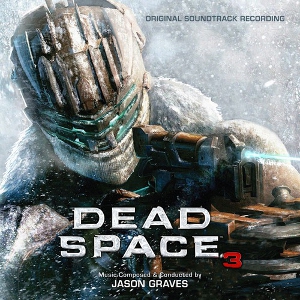Dead Space 3 Original Soundtrack Recording
 |
Album Title: Dead Space 3 Original Soundtrack Recording |
| Record Label: Jason Graves |
|
| Catalog No.: N/A |
|
| Release Date: February 6, 2013 |
|
| Purchase: Stream at SoundCloud |
Overview
One of the most outstanding aspects of the first two Dead Space games had been their soundtracks, both receiving very strong reviews and extensive attention even from non-gaming related publications for their willingness to derive inspiration from atonal 20th century classical music. Franchise composer Jason Graves furthered this connotation through the use of a string quartet on Dead Space 2, while broadening the first game’s limited emotional range. After having thus provided the Dead Space franchise with a recognisable trademark sound, Graves teamed up with James Hannigan, whose body of work includes his outstanding contributions to the Harry Potter and Command & Conquer franchises (in fact Graves and Hannigan had collaborated on Command & Conquer 4: Tiberian Twilight). The change in tone and genre that Dead Space 3 as a whole went through would doubtlessly also impact its music – a development that Graves confirmed in an interview when he stated that “Dead Space 3 has a combination of the classic, original Dead Space horror feel with some modern, edgier appointments.” That soundtrack album was released in February 2012 and contained a generous 83 minutes of music from the game (but sadly no Phil Collins covers), performed by the Philharmonia Orchestra and the Slovak National Symphony Orchestra. At the same time, Graves released a promotional version of the album – Dead Space 3 Original Soundtrack Recording – in both physical form (only distributed to industry members) and via SoundCloud, exclusively containing his compositions and featuring 17 minutes of material that wasn’t made available on the commercial release.
Body
After all the brouhaha over Dead Space 3‘s move into more action-focused waters, it’s important to clearly state one thing up front: Graves’ Dead Space scores have always combined horror and action elements, merging highly atonal textures (and sometimes melodies) with intense rhythms that matched the brutally dissonant string and brass attacks. Another thing to keep in mind is that Dead Space 2 had already moved away somewhat from the intoxicating aural chaos that was Dead Space, structuring its action cues around more straightforward, but still heavy-hitting rhythms. In other words: there’s no reason to believe that just because Dead Space 3 is more of an action game than a horror title that its music would necessarily suffer or be dumped down. Turns out though that this is exactly what happens on Dead Space 3‘s commercial album release, mainly due to Hannigan’s uninspired contributions.
As Dead Space 3‘s promo album focuses exclusively on Graves’ compositions, it doesn’t suffer from the commercial album’s ungainly mix of incompatible musical styles and Hannigan’s mostly derivatively-composed pieces. However, don’t mistake this promo album for a fully-fledged album release that somehow turns out to be the definitive Dead Space 3 music experience. The majority of Graves’ contributions to Dead Space 3 are action pieces written in his trademark dissonant style, and so this promotional release plays like an almost non-stop onslaught of the same style of action music that is already familiar from Dead Space 2, interspersed with interludes of largely nondescript horror underscore. One of the aspects that made Dead Space 2 such an exceptional work was its ability to fuse two diametrically opposed emotions – utmost terror versus despair and fragility – and express them through one coherent musical language, with each side of the equation imbuing the other with gravitas. On the commercial release, this balance was lost due to the greater number of different musical styles that make up Dead Space 3. The promo album also loses that balance, but for the opposite reason – there’s mostly only one genre of music present here, a situation reminiscent of Graves’ score for Dead Space. Ultimately, this promotional release feels like a collection of tracks rather than like a soundtrack with a consistent narrative arc.
That being said, while Graves’ new battle cues largely feel like regurgitations of his previous franchise work, these compositions are still the best thing about Dead Space 3‘s music, so bringing them together on an album like this is certainly not a bad idea. Graves’ compositions strongly recall the particular sound that the Dead Space franchise has become famous for: the extensive use of fierce, biting dissonances particularly in the strings and brass, creating an orchestral frenzy that is as dense as it is powerful. While Graves might by now have gone from innovatively exploring cacophonous material to deploying such sounds by formula, it’s still an effective formula – and one that’s still rarely used in the realm of video game scores. “Stalkers and Fodder and Pods, Oh My!” – or at least its first half – is the prime example of Dead Space 3‘s approach to battle cues, rehashing Dead Space 2‘s action sounds but bringing them back with an impressive amount of ferocious power. Similarly, “Appearance of the Hive Mind” is another one-two punch of sonic fury, backed by alternatively whining, simpering and aggressive violin sounds. Worthy of mention is also the penultimate album track “The Pressure Mounts”, which should have found its way on the commercial album release and is the best composition exclusive to this promo album, a particularly raucous and entertaining slice of orchestral mayhem – for part of its running time.
Truth be told, Graves has made some slight changes to his approach. The rhythms underpinning many of his action tracks are once more simpler than those heard on earlier Dead Space scores and move the music closer to current action game score conventions. However, the slightly diminished rhythmic complexity is no deal breaker, as Graves usually surrounds his pounding percussion patterns with enough orchestral activity to give the music an extra layer of depth and complexity. What’s more noteworthy is a more obvious concession to action scoring conventions that Graves implements: the existence of heroic, uncomplicated brass elements that pay tribute to the game’s sci-fi FPS aspirations. While one might expect that avantgarde-inspired orchestral spikyness and expressions of militaristic nobility would clash badly, the two elements actually work quite well together on “Ship and Slide”, “Ship Repairs… Again” and album exclusive “That’s One Big Drill”. However, fellow action track “The Snow Beast” ultimately lacks rhythmic bite and feels a bit too safe, and the dignified melodic brass lines on several cues can border on the generic.
Unfortunately, this impression of deficient originality is reinforced by the fact that the gallant trumpet melody that caps off “Ship and Slide” is more or less a straight reprise of Graves’ main theme from Resistance: Burning Skies. Given that Burning Skies already suffered from an overuse of this melody, it’s doubly disappointing to see it pop up on Dead Space 3 – not only on “Ship and Slide”, but also later on “Moon Indigo”. Graves makes amends though with “How High the Moon”, which evokes an intriguing sense of wonder through its elegant, chromatic string and brass lines, although the impression only lasts for about a minute. Another track that sees Graves toying with new ideas is “EVA ASAP”, an effective, unsettling battle cue that is happy to experiment a bit through the introduction of synth elements. While the use of electronic percussion sounds feels somewhat forced, the unstable, spectral synth pads that open the piece are an atmospherically successful addition to the sound palette of the Dead Space universe.
Still, a number of factors ensure that Graves’ action material for Dead Space 3‘s ranks below that of Dead Space 2. The biggest culprit is a surprisingly reverb-happy album mix that would be commonplace on a straightforward Remote Control score like Gears of War 3, happy to simply sound big and booming. On a more complex offering like Dead Space 3 though, this approach not only results in a muddy, hollow sound that devours textural detail, but it also blunts the action tracks’ sharp edge. Dead Space 2‘s mix found the perfect balance between forcefulness and a dry sound that vividly captured the music’s abrasive nature. Dead Space 3‘s mix loses this latter asset and robs the soundtrack’s trademark dissonances of some of their impact. Some of the action tracks also simply don’t work too well outside of the game context. For example, “Corpses Delicti” mainly relies on its rhythmic elements, but fails to evoke the same blasted barrenness that made the final portions of Dead Space 2‘s commercial album release such a heady experience. Another issue is the fact that while many of Dead Space 3‘s action tracks pack a wallop once they get going, often enough they also feature significant portions of anonymous, vaguely creepy underscore that genre pundits will have heard on dozens of other film and game scores. “Heart of Darkness” takes a full three minutes of eerie orchestral mumbling before it finally takes off, and “Stalkers and Fodder and Pods, Oh My!”, “Corpses Delicti”, and album exclusives “To Kill a Necromorph” and “The Pressure Mounts” suffer from similar problems. After Dead Space 2 had managed to make even its underscore an integral element of its mesmerising effect, Dead Space 3 unfortunately falls back into the trap of turning its ambient, atmospheric portions into filler material.
Thematic coherency is another field in which Dead Space 3 comes up short against its predecessor, although this comes as even less of a surprise than on the commercial album release. Firstly, a promotional album like this that presents only part of a game’s full soundtrack can’t hope to preserve much the complete work’s thematic structure. Secondly, Grave’s idea to link two of Dead Space 2‘s themes to the protagonist’s girlfriend Nicole was clever enough and served the game perfectly well, but he also wrote himself into a corner. Nicole is entirely gone from Dead Space 3‘s narrative, which means that neither of the two themes associated with her can be reprised at any significant length. What’s stranger though is that Dead Space 2‘s marker theme doesn’t return on Dead Space 3, despite the markers’ prominent role in the game – a pity, since the marker theme and its descending four notes gave many of Dead Space 2‘s action tracks a fatalistic determination.
Those few compositions that show a more emotional, vulnerable side only make up a fraction of this promotional release, but Graves still manages to make at least one of these pieces feel like an essential part of the album. On the closing track “Memories of the Past”, a duet for solo cello and piano suddenly brings back Dead Space 2‘s fragile, touching introspection which otherwise is sorely lacking on this album, all via a surprising reprise of Isaac’s theme from Dead Space 2. Thankfully, Graves develops this mood and the theme in greater length than on the commercial album’s “Knee Deep”, creating Dead Space 3‘s most moving moment – by repeating and elaborating on material already introduced by its predecessor. “A Night in Tau Volantis” and “Baby, It’s Cold Outside” are less remarkable: “A Night in Tau Volanis” returns Dead Space 2‘s regretful tones through a conventional three-note piano motif before Graves nicely mixes in more horror elements that ultimately take over the composition; “Baby, It’s Cold Outside” dishes up mysterious, subdued ‘out there in space’ music with a forbidding undertone that is suitably moody, but ultimately generic.
Summary
Yes, Dead Space 3 Original Soundtrack Recording is better than the commercial soundtrack release – less bloated, stylistically more coherent and free of Hannigan’s mostly uninspired compositions that alternate between trite, lazy string melodies and equally derivative battle cues. Most of this promotional album consists of Graves’ reprising Dead Space 2‘s exciting action material, mixed with some quite standard brass melodies full of military solemnity, and rendered less exciting through the disappointingly muddy and reverberant album mix that results in some serious sound issues. However, Graves’ contributions aren’t consistently convincing on a compositional level, with too many pieces suffering from the inclusion of nondescript underscore. A disappointing, but more or less inevitable lack of thematic material adds to the album’s issues, and while its exclusive tracks range from solid to strong, they don’t offer anything that can’t be found on the commercial release – or on previous Dead Space scores, for that matter. All in all, Dead Space 3 Original Soundtrack Recording is a reasonably satisfying listening experience, but only die-hard fans of the franchise need to seek it out.
Do you agree with the review and score? Let us know in the comments below!
3
Posted on April 29, 2014 by Simon Elchlepp. Last modified on April 29, 2014.














